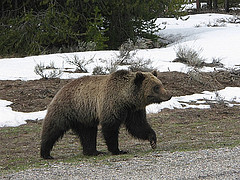
Whenever you see wildlife, it’s always exciting. And, especially as photographers, I think we get even more excited than the average person, and totally forget about safety sometimes in the pursuit of a photograph.
But, it’s important to remember that wildlife can become dangerous if they feel threatened.
If you’re entering bear country, or anywhere there’s potentially dangerous wildlife, please take the time to research how to be safe and what to do in the event that you encounter one of these animals. Many times safety reminders are posted at the trailhead. But, if they’re not, then check with a park ranger. Although these safety guidelines might seem a little overboard sometimes, keep in mind that they’re coming from people who have dedicated their lives to studying these animals.
Remember that a photograph is never worth risking your life for. Be safe.
 About the Author: Steve Berardi is a naturalist, photographer, software engineer, and founder of PhotoNaturalist. You can usually find him hiking in the beautiful mountains and deserts of southern California.
About the Author: Steve Berardi is a naturalist, photographer, software engineer, and founder of PhotoNaturalist. You can usually find him hiking in the beautiful mountains and deserts of southern California.
Putting safety first covers more than just wild animals! Out in the wild, shooting pictures, by myself, pre-sunrise… one wrong step and we can get ourselves in trouble rather easily. I’ve shared personal stories with other photographers where we escaped injuring ourselves by too narrow margins. So, go with a partner and not alone, have someone know where you’re going to be located, look before you leap (as my mother would say). And listen to your mom!
Wise words. I’d only add that one should take along a can of bear spray when out in the woods. (It’s good for mountain lions too). Black bears regularly migrate through our property, and while generally shy, there’s always that one out there. http://humbirdhum.wordpress.com/2012/06/02/the-prowler/
I recently watched an alpha female Roosevelt Elk zero in, leave her herd at Freshwater Beach (RNSP) and make a beeline for a fellow filming his friends surfing about a 1/4 mile down the beach. She passed me and my camera (albeit I had already moved behind a picnic table) without a glance in my direction. There was an interesting standoff between the two of them for several minutes, and she didn’t flinch when he started throwing driftwood – after about 5 minutes she returned to the herd at a full gallop, and resumed her watch from a small sand dune.
Ckeck out a product that is called bear spray . it is kind of like industrial strength pepper spray . made for the purpose of repelling bear attacks . also works on other things . good thing to have in that kind of a spot .
I think it is important to note that bear spray has only about 8 seconds of effective use. I have seen two cans pneumatic the belt of a guy who frequents bear country
Yes, these are all good words of wisdom. I have lived in Alaska for 35 years, hunted, fished, hiked and yes photographed many areas of this state. But one area that scares me so much that I don’t go there is Denalia Ntl Park. The animals are under so much stress from the tourists that visit every summer. I would much rather photograph wild animals outside the park where they are somewhat leery of humans. Yes your chances of seeing wild animals is less, but you are now hunting and looking for them and you much more attune to your’s and their needs. By the way close is not always a good position to be in. The next time you have a can of bear spray, go stand in the path of a semi truck coming at you at 70 miles an hour and wait until it is close enough to spray the driver to stop it. Think about that when using canned spray for a defensive tool.
We don’t know that the bear felt threatened…Grizzlies are an apex predator that have little fear of other animals and could have just attacked him for food.
But best advice for this situation is get a camera with a really good zoom…30x or better. Then you can be suitably far away and still get some great shots.
bear, elk , bison – what I do not get is how so many people can’t even to the simply physics of a several-hundreds-of-pounds animal vs. a human. Yellowstone NP is a great example, where you can distinguish the smart from the soon-to-be-Darwin-award-ed: one kind keep the car between them and the bison, the other doesn’t.
I was reading a blog right after this happened and one of the commenters asked, “How are you supposed to get a good picture if you can’t get close to the bear.” I guess some people still don’t know about telephoto and zoom lenses.
While in Yosemite last year, I saw several dozen people rushing up a hillside trying to get near a female bear and two cubs to take photos. Yelling at them did no good. People on vacation completely fail to take responsibility for themselves because no one they know is around. If they were at home and saw the same, they would run.
Good Day:
I am a licensed outdoor guide ” have been for more than 30yrs” and yes bear spray can be an effective tool in a potential dangerous situations, but not always so don’t be lulled into a false sense of security because your carrying it. Believe it or not there are times that it has not repelled an attack. An equally effective alternative and often easier to locate is a can or two of Wasp & Hornet Spray. Usually spraying up to or more than 20 feet.
Something Important to remember, Black Bears and Grizzly Bears are two different animals and the reason for an attack for each species is often not very applicable to the other.
Grizzly Bears usually attack people because of feeling threatened and usually when they no longer see a person as a viable threat they tend to leave. There is always the exception though where you can become dinner. Black Bears attaches on humans are almost always for predation so doing the fall down cover my head and neck are will not work in that case. While that is very good advise for Grizzly’s and Brown Bears with a Black Bear it will likely get you killed and eaten. The vast majority of the time fighting back as hard as one can will usually save your life when being attacked by Black bears, even when they are acting aggressive are much more tentative than Grizzly’s. There are numerous well documented occurrences where a person seeing an aggressive Black Bear has done the fall down cover yourself thing only to end up realizing that they are being eaten alive have gotten up and literally fought their way out of it so they can live, and have done so. In addition Black Bears are also known for “aggressive appearing” false charges which is one of their behavioral aspect when they do feel threatened. Usually though Black’s run away and hide or climb a tree.
They evolved differently than Grizzly’s in different environments and that is why they developed different behavior reactions to felling threatened.
How will you know if a bear is false charging or is charging to do you harm? That is something that I can not adequately teach over the internet. Writing it down no matter how detailed does not teach you how to read the animals body language which I have learned with over 30 years of guiding.
All of this information can be found on the internet. Or if you wish I can be contacted through my website northernguideservices.com.
Be safe and make it a great day in Our Lords beautiful outdoors.
Johnathan R.
The behaviors of a bear hunting are usually very different from a bear that is reacting to feeling threatened. Usually, Usually when a bear is hunting and other predators as well will try to approach a potential victim in a very stealthy way, where as a head on rush is usually, usually because of the bear perceiving it is in a threatening situation and reacts in a manner so it will feel the situation is safe again, like with a Grizzly sow and cubs. Without being present at the time of attack or able to view the scene afterwards, it would appear in this case is probably from the result of feeling threatened.
However the most important thing to remember that all wild animals are totally unpredictable and should always be give every ounce or respect one can usher. In other words keep your distance and a darn big telephoto is a really, really good idea.
I was up near Lake Louise Canada conducting a photo workshop and we stoped at a scenic area pulloff to watch a grizzley acroos the road toward the back of the meadow. To really get a good picture you needed a 300 or 400 mm lens at the very least. As my students were setting up, we noticed the crowd start to move closer and one idiot, oh I am sorry …tourist, decided that his little point and shoot camera would get a better picture if he charged right up to the bear. I immediately yelled to him to keep back and received a lot of negative feedback from some of the crowd. Comments like, “you can stay back because you have a big lens, the rest of us need to get closer”. Ignorance like that sickens me. I explained to the crowd that not only are they interfing with the normal routine of the bear but if it attacks and hurts or kills someone because it is protecting its territory, a natural instinct, the park rangers will be forced to kill it and potentially its cubs depending on their age. Well fortunately a Park Ranger showed up and managed to move the crowd back without incident.